Tuesday, April 04, 2006
Eta Carinae may be about to explode. But no one knows when - it may be next year, it may be one million years from now. Eta Carinae's mass - about 100 times greater than our Sun - makes it an excellent candidate for a full blown supernova. Historical records do show that about 150 years ago Eta Carinae underwent an unusual outburst that made it one of the brightest stars in the southern sky. Eta Carinae, in the Keyhole Nebula, is the only star currently thought to emit natural LASER light. This image, taken in 1996, resulted from sophisticated image-processing procedures designed to bring out new details in the unusual nebula that surrounds this rogue star. Now clearly visible are two distinct lobes, a hot central region, and strange radial streaks. The lobes are filled with lanes of gas and dust which absorb the blue and ultraviolet light emitted near the center. The streaks remain unexplained. Will these clues tell us how the nebula was formed? Will they better indicate when Eta Carinae will explode?
Sunday, March 05, 2006
The Eagle nebula (M16)
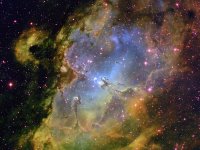 From afar, the whole thing looks like an Eagle. A closer look at the Eagle Nebula, however, shows the bright region is actually a window into the center of a larger dark shell of dust. Through this window, a brightly-lit workshop appears where a whole open cluster of stars is being formed. In this cavity tall pillars and round globules of dark dust and cold molecular gas remain where stars are still forming. Already visible are several young bright blue stars whose light and winds are burning away and pushing back the remaining filaments and walls of gas and dust. The Eagle emission nebula, tagged M16, lies about 6500 light years away, spans about 20 light-years, and is visible with binoculars toward the constellation of Serpens. The above picture combines three specific emitted colors and was taken with the 0.9-meter telescope on Kitt Peak, Arizona, USA.
From afar, the whole thing looks like an Eagle. A closer look at the Eagle Nebula, however, shows the bright region is actually a window into the center of a larger dark shell of dust. Through this window, a brightly-lit workshop appears where a whole open cluster of stars is being formed. In this cavity tall pillars and round globules of dark dust and cold molecular gas remain where stars are still forming. Already visible are several young bright blue stars whose light and winds are burning away and pushing back the remaining filaments and walls of gas and dust. The Eagle emission nebula, tagged M16, lies about 6500 light years away, spans about 20 light-years, and is visible with binoculars toward the constellation of Serpens. The above picture combines three specific emitted colors and was taken with the 0.9-meter telescope on Kitt Peak, Arizona, USA.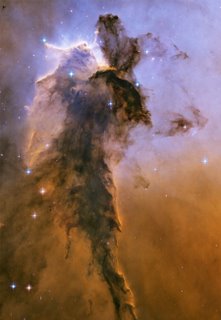 The dust sculptures of the Eagle Nebula are evaporating. As powerful starlight whittles away these cool cosmic mountains, the statuesque pillars that remain might be imagined as mythical beasts. Pictured above is one of several striking dust pillars of the Eagle Nebula that might be described as a gigantic alien fairy. This fairy, however, is ten light years tall and spews radiation much hotter than common fire. The greater Eagle Nebula, M16, is actually a giant evaporating shell of gas and dust inside of which is a growing cavity filled with a spectacular stellar nursery currently forming an open cluster of stars. The above image in scientifically re-assigned colors was released as part of the fifteenth anniversary celebration of the launch of the Hubble Space Telescope.
The dust sculptures of the Eagle Nebula are evaporating. As powerful starlight whittles away these cool cosmic mountains, the statuesque pillars that remain might be imagined as mythical beasts. Pictured above is one of several striking dust pillars of the Eagle Nebula that might be described as a gigantic alien fairy. This fairy, however, is ten light years tall and spews radiation much hotter than common fire. The greater Eagle Nebula, M16, is actually a giant evaporating shell of gas and dust inside of which is a growing cavity filled with a spectacular stellar nursery currently forming an open cluster of stars. The above image in scientifically re-assigned colors was released as part of the fifteenth anniversary celebration of the launch of the Hubble Space Telescope.
The Crab Nebula (M1)
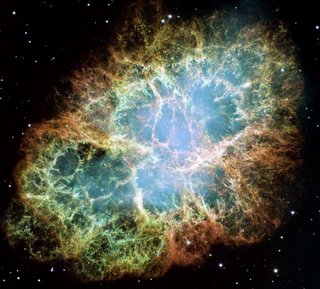 The Crab Nebula is cataloged as M1, the first object on Charles Messier's famous list of things which are not comets. In fact, the cosmic Crab is now known to be a supernova remnant, an expanding cloud of debris from the death explosion of a massive star. Light from that stellar catastrophe was first witnessed by astronomers on planet Earth in the year 1054. Composed of 24 exposures taken in October 1999, January 2000, and December 2000, this Hubble Space Telescope mosaic spans about twelve light years. Colors in the intricate filaments trace the light emitted from atoms of hydrogen, oxygen, and sulfur in the debris cloud. The spooky blue interior glow is emitted by high-energy electrons accelerated by the Crab's central pulsar. One of the most exotic objects known to modern astronomers, the pulsar is a neutron star, the spinning remnant of the collapsed stellar core. The Crab Nebula lies about 6,500 light-years away in the constellation Taurus.
The Crab Nebula is cataloged as M1, the first object on Charles Messier's famous list of things which are not comets. In fact, the cosmic Crab is now known to be a supernova remnant, an expanding cloud of debris from the death explosion of a massive star. Light from that stellar catastrophe was first witnessed by astronomers on planet Earth in the year 1054. Composed of 24 exposures taken in October 1999, January 2000, and December 2000, this Hubble Space Telescope mosaic spans about twelve light years. Colors in the intricate filaments trace the light emitted from atoms of hydrogen, oxygen, and sulfur in the debris cloud. The spooky blue interior glow is emitted by high-energy electrons accelerated by the Crab's central pulsar. One of the most exotic objects known to modern astronomers, the pulsar is a neutron star, the spinning remnant of the collapsed stellar core. The Crab Nebula lies about 6,500 light-years away in the constellation Taurus.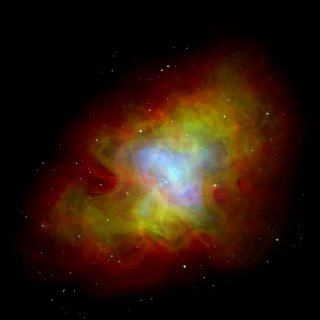 This is the mess that is left when a star explodes. The Crab Nebula, the result of a supernova seen in 1054 AD, is filled with mysterious filaments. The filaments are not only tremendously complex, but appear to have less mass than expelled in the original supernova and a higher speed than expected from a free explosion. The above image, taken by the Nordic Optical Telescope (NOT), is in three colors chosen for scientific interest. The Crab Nebula spans about 10 light-years. In the nebula's very center lies a pulsar: a neutron star as massive as the Sun but with only the size of a small town. The Crab Pulsar rotates about 30 times each second.
This is the mess that is left when a star explodes. The Crab Nebula, the result of a supernova seen in 1054 AD, is filled with mysterious filaments. The filaments are not only tremendously complex, but appear to have less mass than expelled in the original supernova and a higher speed than expected from a free explosion. The above image, taken by the Nordic Optical Telescope (NOT), is in three colors chosen for scientific interest. The Crab Nebula spans about 10 light-years. In the nebula's very center lies a pulsar: a neutron star as massive as the Sun but with only the size of a small town. The Crab Pulsar rotates about 30 times each second.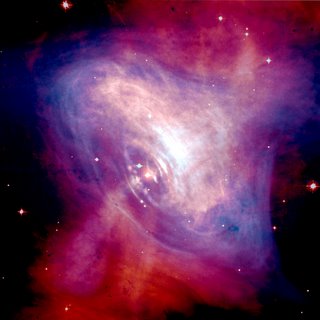 The Crab Pulsar, a city-sized, magnetized neutron star spinning 30 times a second, lies at the center of this composite image of the inner region of the well-known Crab Nebula. The spectacular picture combines optical data (red) from the Hubble Space Telescope and x-ray images (blue) from the Chandra Observatory, also used in the popular Crab Pulsar movies. Like a cosmic dynamo the pulsar powers the x-ray and optical emission from the nebula, accelerating charged particles and producing the eerie, glowing x-ray jets. Ring-like structures are x-ray emitting regions where the high energy particles slam into the nebular material. The innermost ring is about a light-year across. With more mass than the Sun and the density of an atomic nucleus, the spinning pulsar is the collapsed core of a massive star that exploded, while the nebula is the expanding remnant of the star's outer layers. The supernova explosion was witnessed in the year 1054.
The Crab Pulsar, a city-sized, magnetized neutron star spinning 30 times a second, lies at the center of this composite image of the inner region of the well-known Crab Nebula. The spectacular picture combines optical data (red) from the Hubble Space Telescope and x-ray images (blue) from the Chandra Observatory, also used in the popular Crab Pulsar movies. Like a cosmic dynamo the pulsar powers the x-ray and optical emission from the nebula, accelerating charged particles and producing the eerie, glowing x-ray jets. Ring-like structures are x-ray emitting regions where the high energy particles slam into the nebular material. The innermost ring is about a light-year across. With more mass than the Sun and the density of an atomic nucleus, the spinning pulsar is the collapsed core of a massive star that exploded, while the nebula is the expanding remnant of the star's outer layers. The supernova explosion was witnessed in the year 1054.
The Cat's Eye Nebula (NGC 6543)
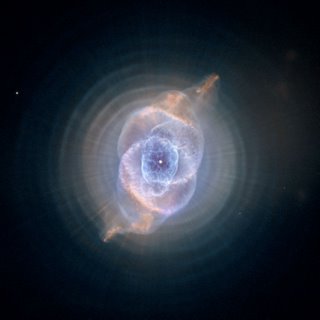
The Cat's Eye Nebula (NGC 6543) is one of the best known planetary nebulae in the sky. Staring across interstellar space, the alluring nebula lies three thousand light-years from Earth.
A classic planetary nebula, the Cat's Eye (NGC 6543) represents a final, brief yet glorious phase in the life of a sun-like star. This nebula's dying central star may have produced the simple, outer pattern of dusty concentric shells by shrugging off outer layers in a series of regular convulsions. But the formation of the beautiful, more complex inner structures is not well understood.
Its haunting symmetries are seen in the very central region of this stunning false-color picture, processed to reveal the enormous but extremely faint halo of gaseous material, over three light-years across, which surrounds the brighter, familiar planetary nebula. Made with data from the Nordic Optical Telescope in the Canary Islands, the composite picture shows emission from nitrogen atoms as red and oxygen atoms as green and blue shades. Planetary nebulae have long been appreciated as a final phase in the life of a sun-like star. Only much more recently however, have some planetaries been found to have halos like this one, likely formed of material shrugged off during earlier active episodes in the star's evolution. While the planetary nebula phase is thought to last for around 10,000 years, astronomers estimate the age of the outer filamentary portions of this halo to be 50,000 to 90,000 years.
Barred Spiral Galaxy NGC 1300
 NGC 1300 is a large spiral galaxy of type SBbc in the constellation Eridanus that appears as a flattened figure eight. A huge bar that spans over 150,000 light-years across the galaxy center dominates its appearance. The picturesque galaxy lies about 75 million light-years distant, so that light that we see now left during the age of the dinosaurs. Although it is well known how fast different parts of NGC 1300 rotate, the specific orbits of many component stars -- including how they interact with the gigantic bar -- remains a topic of research. Our own Milky Way Galaxy is a spiral galaxy with a less prominent bar. NGC 1300 can be seen with a small telescope towards the constellation of Eridanus.
NGC 1300 is a large spiral galaxy of type SBbc in the constellation Eridanus that appears as a flattened figure eight. A huge bar that spans over 150,000 light-years across the galaxy center dominates its appearance. The picturesque galaxy lies about 75 million light-years distant, so that light that we see now left during the age of the dinosaurs. Although it is well known how fast different parts of NGC 1300 rotate, the specific orbits of many component stars -- including how they interact with the gigantic bar -- remains a topic of research. Our own Milky Way Galaxy is a spiral galaxy with a less prominent bar. NGC 1300 can be seen with a small telescope towards the constellation of Eridanus.
Dusty Galaxy Centaurus A (NGC 5128)
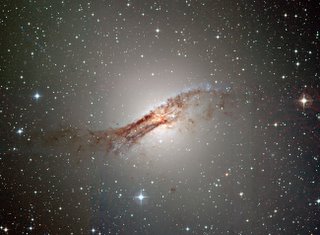 Why is peculiar galaxy Centaurus A so dusty? Dramatic dust lanes that run across the galaxy's center mark Cen A. These dust lanes are so thick they almost completely obscure the galaxy's center in visible light. This is particularly unusual as Cen A's red stars and round shape are characteristic of a giant elliptical galaxy, a galaxy type usually low in dark dust. Cen A, also known as NGC 5128, is also unusual compared to an average elliptical galaxy because it contains a higher proportion of young blue stars and is a very strong source of radio emission. Evidence indicates that Cen A is likely the result of the collision of two normal galaxies. During the collision, many young stars were formed, but details of the creation of Cen A's unusual dust belts are still being researched. Cen A lies only 13 million light years away, making it the closest active galaxy. Cen A spans 60,000 light years and can be seen with binoculars toward the constellation of Centaurus.
Why is peculiar galaxy Centaurus A so dusty? Dramatic dust lanes that run across the galaxy's center mark Cen A. These dust lanes are so thick they almost completely obscure the galaxy's center in visible light. This is particularly unusual as Cen A's red stars and round shape are characteristic of a giant elliptical galaxy, a galaxy type usually low in dark dust. Cen A, also known as NGC 5128, is also unusual compared to an average elliptical galaxy because it contains a higher proportion of young blue stars and is a very strong source of radio emission. Evidence indicates that Cen A is likely the result of the collision of two normal galaxies. During the collision, many young stars were formed, but details of the creation of Cen A's unusual dust belts are still being researched. Cen A lies only 13 million light years away, making it the closest active galaxy. Cen A spans 60,000 light years and can be seen with binoculars toward the constellation of Centaurus.
Friday, March 03, 2006
The Rosette Nebula (NGC 2237)

The Rosette Nebula is a large emission nebula located 3000 light-years away. The great abundance of hydrogen gas gives NGC 2237 its red color in most photographs. The wind from the open cluster of stars known as NGC 2244 has cleared a hole in the nebula's center.
The above photograph, however, was taken in the light emitted by three elements of the gas ionized by the energetic central stars. Here green light originating from oxygen and blue light originating from sulfur supplements the red from hydrogen. Filaments of dark dust lace run through the nebula's gases. The origin of recently observed fast-moving molecular knots in the Rosette Nebula remains under investigation.
The N44 Superbubble
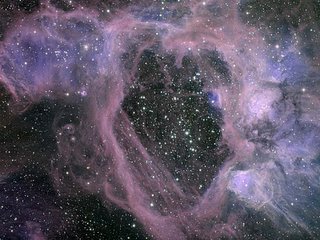
What created this gigantic hole?
Astronomers believe one or more of the stars in the cluster blew up, blowing out a hole about 325 by 250 light-years across.
N44 is one of the largest and most intricate nebulas in this part of the universe. Located in
our galactic neighbor the Large Magellanic Cloud, N44 houses numerous massive bright stars, lengthy lanes of dark dust, and vast clouds of hydrogen gas that glows red.
N44 is classified as an emission nebula because it contains large regions of ionized hydrogen. A close analysis of N44's tunnel-like structure can tell astronomers a lot about the dynamics behind cosmic blasts. One possibility is particle winds expelled by massive stars in the bubble's interior that are pushing out the glowing gas. This answer has been recently found to be inconsistent with measured wind velocities, however.
Another possibility is that the expanding shells of old supernovas have sculpted the unusual space cavern. An unexpected clue of hot X-ray emitting gas was recently been detected escaping the N44 superbubble. The above image, here digitally sharpened, was taken in three very specific colors by the huge 8-meter Gemini South Telescope on Cerro Pachon in Chile.
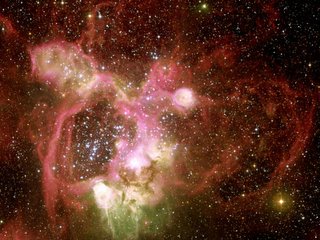 The red color of the N44 emission nebula comes from pervasive hydrogen atoms re-acquiring electrons that were knocked away by energetic light from massive stars. The central stars also appear to have somehow created the huge superbubble visible in the lower left. N44, pictured beside, spans about 1,000 light years and lies about 170,000 light years distant.
The red color of the N44 emission nebula comes from pervasive hydrogen atoms re-acquiring electrons that were knocked away by energetic light from massive stars. The central stars also appear to have somehow created the huge superbubble visible in the lower left. N44, pictured beside, spans about 1,000 light years and lies about 170,000 light years distant.A combinde image of visible light with images in infrared light and X-rays, provided by ESO.
At the centre of this very rich region of gas, dust and young stars lies the star cluster NGC 1929. Its massive stars produce intense radiation, expel matter at high speeds as stellar winds, and race through their short but brilliant lives to explode as supernovae. The winds and supernova shock waves have carved out a huge cavity, called a superbubble, in the surrounding gas.
 Observations with NASA's Chandra X-ray Observatory (shown here in blue) reveal hot regions created by these winds and shocks, while infrared data from NASA's Spitzer Space Telescope (shown in red) outline where the dust and cooler gas are found. The visible-light view from the MPG/ESO 2.2-metre telescope (in yellow) completes the picture and shows the hot young stars themselves as well as the glowing clouds of gas and dust that surround them.
Observations with NASA's Chandra X-ray Observatory (shown here in blue) reveal hot regions created by these winds and shocks, while infrared data from NASA's Spitzer Space Telescope (shown in red) outline where the dust and cooler gas are found. The visible-light view from the MPG/ESO 2.2-metre telescope (in yellow) completes the picture and shows the hot young stars themselves as well as the glowing clouds of gas and dust that surround them.
The Helix Nebula
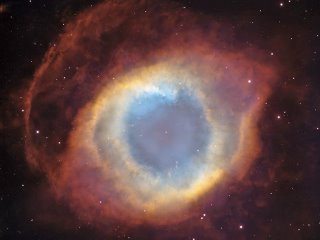 How did a star create the Helix nebula? The shapes of planetary nebula like the Helix are important because they likely hold clues to how stars like the Sun end their lives. Recent observations by the orbiting Hubble Space Telescope and the 4-meter Blanco Telescope in Chile, however, have shown the Helix is not really a simple helix. Rather, it incorporates two nearly perpendicular disks as well as arcs, shocks, and even features not well understood. Even so, many strikingly geometric symmetries remain. How a single Sun-like star created such beautiful yet geometric complexity is a topic of research. The Helix Nebula is the nearest planetary nebula to Earth, lies only about 700 light years away toward the constellation of Aquarius, and spans about 3 light-years.
How did a star create the Helix nebula? The shapes of planetary nebula like the Helix are important because they likely hold clues to how stars like the Sun end their lives. Recent observations by the orbiting Hubble Space Telescope and the 4-meter Blanco Telescope in Chile, however, have shown the Helix is not really a simple helix. Rather, it incorporates two nearly perpendicular disks as well as arcs, shocks, and even features not well understood. Even so, many strikingly geometric symmetries remain. How a single Sun-like star created such beautiful yet geometric complexity is a topic of research. The Helix Nebula is the nearest planetary nebula to Earth, lies only about 700 light years away toward the constellation of Aquarius, and spans about 3 light-years. Over six hundred light years from Earth, in the constellation Aquarius, a sun-like star is dying. Its last few thousand years have produced the Helix Nebula (NGC 7293), a well studied and nearby example of a Planetary Nebula, typical of this final phase of stellar evolution. Emission in this infrared Spitzer Space Telescope image of the Helix comes mostly from the nebula's molecular hydrogen gas. The gas appears to be clumpy, forming thousands of comet-shaped knots each spanning about twice the size of our solar system. Bluer, more energetic radiation is seen to come from the heads with redder emission from the tails, suggesting that they are more shielded from the central star's winds and intense ultraviolet radiation. The nebula itself is about 2.5 light-years across. The Sun is expected to go through its own Planetary Nebula phase ... in another 5 billion years.
Over six hundred light years from Earth, in the constellation Aquarius, a sun-like star is dying. Its last few thousand years have produced the Helix Nebula (NGC 7293), a well studied and nearby example of a Planetary Nebula, typical of this final phase of stellar evolution. Emission in this infrared Spitzer Space Telescope image of the Helix comes mostly from the nebula's molecular hydrogen gas. The gas appears to be clumpy, forming thousands of comet-shaped knots each spanning about twice the size of our solar system. Bluer, more energetic radiation is seen to come from the heads with redder emission from the tails, suggesting that they are more shielded from the central star's winds and intense ultraviolet radiation. The nebula itself is about 2.5 light-years across. The Sun is expected to go through its own Planetary Nebula phase ... in another 5 billion years.
The Red Lagoon (M8)
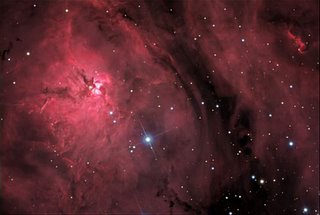
Objects in space often get more than one name. The Lagoon Nebula got its popular name from a band of dust to the left of a cluster of stars. Officially the open star cluster is named NGC 6530, and the nebula is called M8 or NGC 6523.
Whatever, it sure is pretty.
This view was made earlier in May by amateurs Jack Harvey and Tom Doughtery, with the help of a professional astronomer at a nightly observing program at the Kitt Peak National Observatory in Arizona. The program is designed to introduce total amateurs to the art and science of astronomy and astrophotography.
The nebula is home to young stars, hot gas and dust. The open cluster of stars is young, having developed several million years ago, compared to our Sun which is 4.6 billion years old.
Oh, and there's one more name to mention. In the middle of the nebula is a bright knot of gas and dust called the Hourglass Nebula.
Pinwheel (NGC 1309)
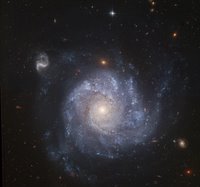 Like a pinwheel in the wind, the spiral galaxy NGC 1309 presents its full face towards the Hubble Space Telescope (HST).
Like a pinwheel in the wind, the spiral galaxy NGC 1309 presents its full face towards the Hubble Space Telescope (HST).This image, a combination of visible and infrared observations, highlights several features of NGC 1309, which sits some 100 million light-years from Earth part of the Eridanus (the River) group of about 200 galaxies. The blue areas indicate star formation along the galaxy’s spiral arms, while wispy dust lanes wind their way into its yellow central nucleus.
Astronomers use NGC 1309 to measure the expansion rate of the universe, relying on a stellar explosion – a Type Ia supernova dubbed 2002fk – which lit up its galactic home in September 2002. Type Ia supernovas are useful because they allow astronomers to better measure distances of objects from each other.
For example, by comparing nearby Type Ia supernovae to more distant ones, researchers are were able to determine not only that the universe is expanding, but that the expansion is accelerating. However, the method only works if the distance to the host galaxies is known extremely well.
NGC 1309 also contains Cepheid variable stars, which shift in brightness at different rates, allowing astronomers to deduce their distance.
Clouds of Orion

Clouds teem with gas and dust in this close-up of the Orion Nebula.
Astronomers combined observations taken by the Hubble Space Telescope’s Advanced Camera for Surveys (ACS) with those by ground-based observatories to build a comprehensive view of the Orion Nebula.
This image is just part of a 520-piece mosaic of photographs obtained between 2004 and 2005 in five colors. The larger mosaic covers a patch of sky about equivalent to that of the full Moon. The pillars of dark dust reaching down from the top of this view are resisting erosion from the intense ultraviolet light cast off by the nebula’s largest stars, astronomers said.
Thursday, March 02, 2006
Galaxy 101

The Hubble Space Telescope captures the most detailed image ever taken of a spiral galaxy.
Astronomers stitched together 51 separate images from Hubble – with a few other details from ground-based instruments – to build this mosaic of Messier 101, also known as the Pinwheel Galaxy. At an impressive 16,000 by 12,000 pixels, the image is the largest and most detailed ever caught of a spiral galaxy.
The Pinwheel Galaxy is about 170,000 light-years wide, almost twice the diameter of our own Milky Way, and is estimated to contain at least one trillion stars. Astronomers believe that perhaps 100 billion of those stars may be similar to our Sun, and millions of individual objects can be picked from this image.
The galaxy itself sits about 25 million light-years away toward the northern constellation Ursa Major. The light that reached Earth to build this portrait left the Pinwheel Galaxy during our planet’s Miocene Period, when the first mastodon appeared and mammals were flourishing.
The Splendor of Orion: A Star Factory Unveiled
Hubble Sheds Light on Dark Matter
New Animation: Hubble Spots Cosmic Traffic Jam
Mensa on Mars

Once part of a grand mountain, the remains of Ausonia Mensa rise up from the surface of Mars.
The European Space Agency’s Mars Express craft built this perspective view of Ausonia Mensa with its high-resolution camera. The feature is a large remnant mountain that sports several craters as it stretches to an elevation of about 3,700 meters. The mountain covers a swath of Mars that runs 98 kilometers long and about 48 kilometers wide.
A large crater, approximately 7.5 kilometers in diameter and 870 meters deep, has been partially filled with sediment, while a large gully cuts across the northern flank. The western flank of the mountain is dominated by a large crater, about six kilometers in diameter.


